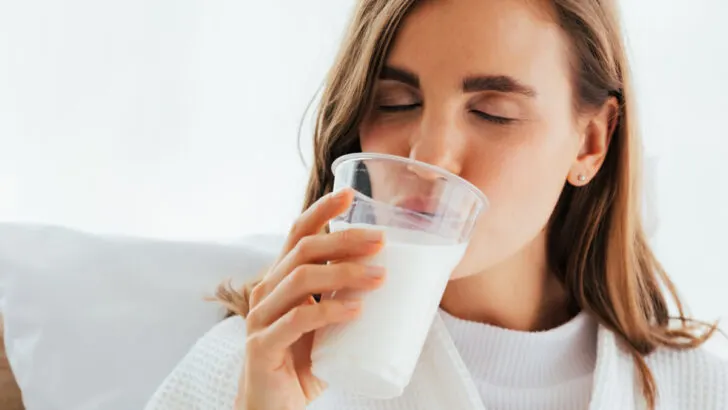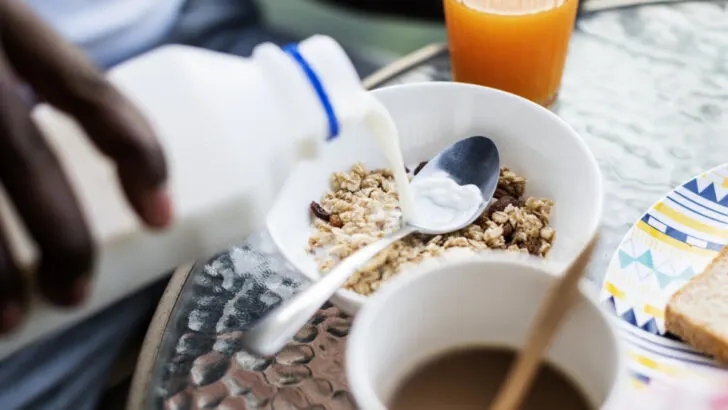Though there are many applications for evaporated milk, the real story lies in whether you can drink it or not.
You can drink evaporated milk. Most people choose to drink it directly from the can, but you can also dilute it with water. If you want to gain weight, add it to your smoothies or have it with your favorite meal.
Now that you know you can drink evaporated milk, read on to check out how it tastes.
How Does Evaporated Milk Taste?
In most cases, evaporated milk has a slightly nutty or caramel-like flavor. The texture is more velvety and dense than regular milk.
Since the process requires heating to promote evaporation, the sugar in the milk caramelizes. This imparts a touch of color and a slight sense of sweetness compared to regular milk.
When raw milk is boiled, the milk’s protein, fat, and sugar condense into a smaller volume of liquid, making the milk thicker.
The flavor produced by this process is more potent than fresh milk.
The flavor of reconstituted evaporated milk is said to be more similar to the flavor of fresh milk. Despite this, a significant number of people will still detect a distinction.
You may mask the difference and make it appear more like fresh milk by adding a little vanilla flavor to the mixture.
Even though its distinctive taste can take some getting used to, many people consider evaporated milk rather delicious. In addition to its versatility in the kitchen, it can be used in various recipes.

Is Evaporated Milk Healthy To Drink?
Drinking evaporated milk might help those who want to eat more food or get more minerals.
Being underweight is a risk factor for dementia, infection, and possibly mortality. You can help overcome this by drinking evaporated milk to avoid additional health issues linked to poor eating habits.
Because of its high level of nutrients and less sugar, evaporated milk might help you healthily gain weight.
In addition to being consumed, evaporated milk can be used to make various foods, including porridge, mashed potatoes, casseroles, and soups.
Additionally, evaporated milk is naturally high in minerals like phosphorus and calcium, which are crucial for bone health. It is supplemented with Vitamin D and, occasionally, Vitamin A.
What Is Evaporated Milk’s Nutritional Content?
Internationally, milk’s nutritional makeup is regulated by the Codex Alimentarius.
In contrast, the Code of Federal Regulations (CFR) governs it in the United States.
The CFR specifies that evaporated milk must have at least 6.5% milk fat, 23% milk solids by weight, and 6.5% milk solids-not-fat (MSNF). However, whole, low-fat, and fat-free milk can all be used to make evaporated milk.
1 cup or 240 mL of whole evaporated milk has 338 calories, 25 grams of carbs, and 19 grams of fat. Whereas 1 cup of fresh cow’s milk has 149 calories, 12 grams of carbs, and 8 grams of fat.
In general, evaporated milk has twice as many grams of carbohydrates, proteins, and fats, with the exception of the variants that have reduced fat levels.
For example, compared to fresh milk, all the varieties of evaporated milk provide more than 50% of the DV (Daily Volume) for calcium, 18% for zinc, and 15% for Daily Volume for magnesium.
On the other hand, fresh milk only contains 21%, 8% and 6% of these nutrients respectively.
Although calcium is necessary for strong bones, magnesium is essential for a healthy brain, heart, and muscles. Whereas zinc is required for healthy growth, digestion, and immune function.
On the other hand, comparing evaporated milk to sweetened condensed milk might make more substantial distinctions between the two.
For instance, one ounce of sweetened condensed milk contains 122 calories, 3 grams of fat, 3 grams of protein, and 20 grams of sugar, approximately the same amount as one cup of whole evaporated milk.
Can You Drink Evaporated Milk With Cereal?
Evaporated milk is a fantastic method of eating your cornflakes in the morning.
It is preferable to first dilute or reconstitute evaporated milk with water before adding it to your cereal. Reconstituted evaporated milk provides the appropriate consistency for a bowl of cereal.
However, evaporated milk straight out of the can is too thick.

People who prefer a warm cereal bowl can add evaporated milk because sealed cans of the product do not require refrigeration.
If you enjoy a thick cup of oats without additional liquid, you can cook it using evaporated milk.
What Are Some Other Uses Of Evaporated Milk?
Many recipes that call for a creamy dairy flavor but don’t require the additional liquid of fresh milk use evaporated milk.
Evaporated milk works well in savory and sweet meals because no additional sugar is added. A sauce, such as a béchamel, spaghetti, or cheese sauce, is frequently thickened by evaporated milk.
This method increases thickness without increasing fat content.
Many drinks benefit greatly from the addition of evaporated milk. To give a smoothie a creamier texture, use it in place of yogurt or fresh milk.
Similarly, you can make a milkshake by combining ice cream with evaporated milk.
The result is a milkshake that is so rich and ultra-creamy that a spoon should be used instead of a straw. Try creating hot chocolate using evaporated milk: combine equal parts evaporated milk and whole milk for a cozier treat.
Additionally, tea and lattes taste delicious when made with evaporated milk.
Evaporated milk is ideal for achieving a smooth smoothness in savory meals. Instead of milk and butter, you can substitute evaporated milk to give mashed potatoes, carrots, macaroni, and cheese a thick, creamy consistency.
Another simple method for improving the flavor and consistency of canned sauces and soups is to add evaporated milk.
Additionally, evaporated milk plays a significant role in various sweets and pastries, including puddings, pies, cakes, flans, and scones.
Disadvantages Of Using Evaporated Milk
As it has more protein and lactose per volume than conventional milk, evaporated milk may present problems for those who are lactose intolerant or allergic to cow’s milk.
The primary form of carb in dairy products and milk is lactose.
Because they lack the enzyme lactase, individuals with lactose intolerance might experience diarrhea, bloating, or abdominal pain after consuming lactose.
According to some studies, individuals with lactose intolerance could be able to take up to 15 grams of lactose per day, or around 1-2 cups of milk.
Still, given its greater glucose content, evaporated milk may contain more than twice as much lactose as fresh milk.
CMA is an immune-mediated response to the proteins in the milk, meaning that within minutes or as long as 2 hours after consuming milk, your body’s defense system targets milk proteins.
One of the most prevalent food allergies in children, influencing up to 3% of kids in affluent nations, is lactose intolerance which can cause mild to severe symptoms.
Evaporated milk might not be a good choice for people with CMA because it is produced with intact milk proteins and contains more protein per cup than fresh milk.
Avoiding milk products appears to be the principal and most successful treatment in both situations.
Final Words on Drinking Evaporated Milk
It is possible to use evaporated milk in a number of different recipes as a suitable alternative to fresh cow’s milk.
Additionally, if you are aiming to acquire weight, drink evaporated milk due to its additional fat and carbohydrate level as compared to cow’s milk.


